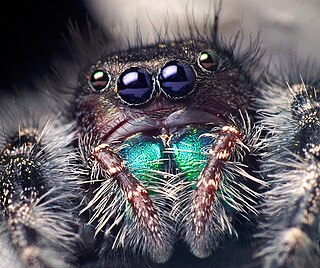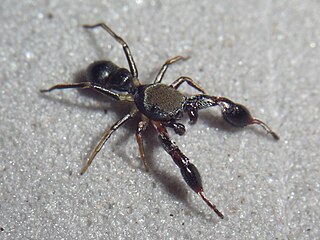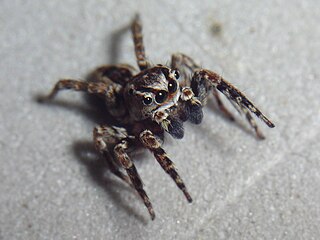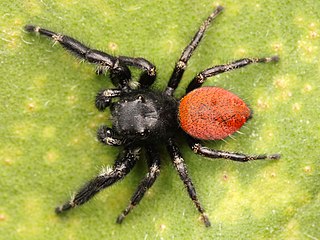
Phidippus is a genus in the family Salticidae. Some of the largest jumping spiders inhabit this genus, and many species are characterized by their brilliant, iridescent green chelicerae. Phidippus is distributed almost exclusively in North America, with the exception of two exported species. As of January 2021, there were about 80 described species in the genus. Species previously described in Phidippus which are found in India and Bangladesh do not belong in this genus.

Phidippus audax, the Bold jumper or Daring jumping spider, is a common species of spider belonging to the genus Phidippus, a group of jumping spiders easily identified by their large eyes and their iridescent chelicerae. Like all jumping spiders, they have excellent stereoscopic vision that aids them in stalking prey and facilitates visual communication with potential mates during courting. Bold jumping spiders are native to North America and have been introduced to Hawaii, Nicobar Islands, Azores, and the Netherlands. They are typically black with a distinct white triangle on their abdomen.

Attidops is a genus of jumping spiders. It is closely related to the genera Ballus, Admestina and Icius.

Bellota is a genus of jumping spiders that was first described by George Peckham & Elizabeth Peckham in 1892. It is similar in appearance to the genus Chirothecia, but has a narrower cephalothorax and a shorter eye area.

Hentzia is a genus of the spider family Salticidae subfamily Dendryphantinae. The genus is widespread in North America and northern South America but the center of biodiversity seems to be primarily in the Caribbean and surrounding areas, with the greatest species diversity occurring in Cuba, which has seven species. Some outlier species, such as Hentzia poenitens and Hentzia fimbriata are found in western North America. It appears to be closely related to the genus Anicius from which it differs primarily in certain anatomical details.

Marpissa is a genus of jumping spiders that was first described by Carl Ludwig Koch in 1846. The name is derived from Marpissa, an ancient Greek village.

Mexigonus is a genus of North American jumping spiders that was first described by G. B. Edwards in 2003. The name is a reference to Mexico, where the first identified species were found.

Paramarpissa is a genus of North American jumping spiders that was first described by Frederick Octavius Pickard-Cambridge in 1901. Originally considered a synonym of Pseudicius, it was separated into its own genus in 1999.

Pelegrina is a spider genus of the family Salticidae. They are found throughout North America. Many of the species in Pelegrina were previously placed in the genera Metaphidippus, and before that, Dendryphantes. The genus was originally described in 1930 by the Spanish arachnologist Pelegrín Franganillo Balboa, who named it after himself.

Platycryptus is a genus of jumping spiders that was first described by D. E. Hill in 1979. The name comes from the Greek platy meaning flat and crypt meaning hidden, as these spiders are squat and will frequently hide in crevices. They have hairy bodies with a cryptic gray and brown color pattern. They live on or under the bark of trees, and can be found on man-made wooden structures.

Zygoballus is a genus of jumping spiders found in North and South America.

Phidippus johnsoni, the red-backed jumping spider or Johnson jumping spider, is one of the largest and most commonly encountered jumping spiders of western North America. It is not to be confused with the unrelated and highly venomous redback spider.

Zygoballus sexpunctatus is a species of jumping spider which occurs in the southeastern United States where it can be found in a variety of grassy habitats. Adult spiders measure between 3 and 4.5 mm in length. The cephalothorax and abdomen are bronze to black in color, with reddish brown or yellowish legs. The male has distinctive enlarged chelicerae and front femora. Like many jumping spiders, Z. sexpunctatus males exhibit ritualized courtship and agonistic behavior.

Zygoballus nervosus is a species of jumping spider which occurs in the eastern United States and Canada.

Anasaitis canosus, previously of the genus Corythalia, is a small jumping spider that can typically be found atop leaf-litter or man-made structures such as fences and exterior walls. This species is more commonly known as the twin-flagged jumping spider due to the two pennant shaped markings on the dorsal side of the cephalothorax. Typical of the genus Anasaitis, this species has iridescent setae ("scales") which may appear white, green or pink which create the "flags" as well as patches on the male pedipalps used in courtship and intraspecific signaling. This species is roughly 5 to 6 mm in length. A. canosus ranges from Mexico to South Carolina along the Gulf of Mexico.
Admestina archboldi is a species of jumping spider found in the southern United States. The species was first described in 1992 by William Piel.

Admestina tibialis is a species of jumping spider. The species was first described in 1846 by C. L. Koch. These spiders are found in eastern United States from Florida to Connecticut.

Admestina wheeleri, also known as the thick-legged jumping spider, is a species of jumping spider found in the northern United States and southern Canada.

Lyssomanes viridis, commonly known as the magnolia green jumper, is a species of jumping spider of the genus Lyssomanes, for which it is the type species. The species' native range extends through much of North America and Central America.

Zygoballus minutus is a species of jumping spider in the genus Zygoballus that was first identified in Guatemala. The spider has also been found in Mexico, and the distribution may extend across Central America. Zygoballus minutus was first described by George and Elizabeth Peckham in 1898. It is a small spider, which is recalled in the name, which is the Latin for small, ranging in length between 3.5 and 4 mm. The male is distinguished by bands of white hair on the abdomen while the female has a pattern of streaks and bands. The palpal bulbs, which are reddish-brown on the male and yellow on the female, are also a distinguishing feature from other species in the genus.



















